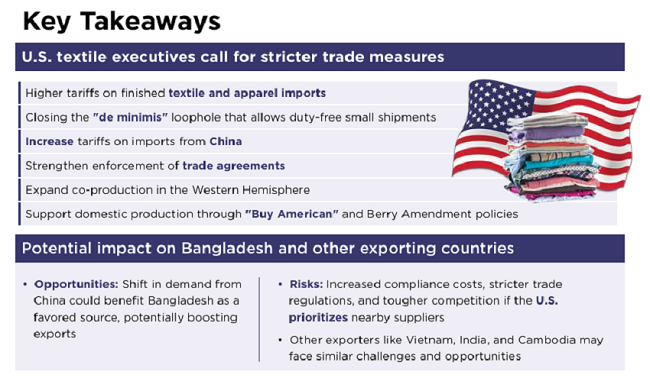China's Trade Policy Shift: Implications For US-Made Goods

Table of Contents
Increased Tariffs and Trade Barriers
China's implementation of increased tariffs and non-tariff barriers presents a significant hurdle for US-made goods. These measures, often retaliatory in nature, directly impact the competitiveness and pricing of American products in the Chinese market. Specific examples include increased tariffs on agricultural products like soybeans and pork, as well as higher duties on manufactured goods and technology components.
- Specific examples of tariff increases: In recent years, tariffs on various US goods have fluctuated, reaching as high as 25% on certain products, significantly impacting pricing.
- Impact on specific sectors: The agricultural sector, particularly soybean farmers, has been severely impacted by Chinese tariffs. The technology sector has also faced significant challenges due to restrictions on the import of advanced technology.
- Quantifiable data on export volume changes: Data reveals a notable decrease in US export volumes to China across multiple sectors since the imposition of these tariffs, highlighting the direct impact of these trade barriers.
Shifting Supply Chains and Reshoring
China's trade policy changes are accelerating a global trend: the reshoring and nearshoring of manufacturing operations. Companies are actively seeking to diversify their supply chains, reducing their reliance on Chinese manufacturing. This shift is driven by concerns over geopolitical instability, tariff unpredictability, and the desire to mitigate supply chain risks.
- Examples of companies relocating production: Several major companies have announced plans to relocate or expand production outside of China, including in countries like Vietnam, Mexico, and even the US.
- Costs associated with reshoring: Reshoring involves significant upfront costs, including investment in new facilities, labor costs (potentially higher in some regions), and increased transportation expenses.
- Potential benefits of reshoring: The advantages include enhanced supply chain resilience, reduced dependence on a single country for manufacturing, and the potential for increased domestic job creation in the US.
Impact on US Businesses and Consumers
The implications of China's trade policy shift extend beyond US exporters. The overall economic consequences for US businesses are complex, involving both job losses in sectors heavily reliant on Chinese exports and potential job creation in sectors benefiting from reshoring. Consumers, meanwhile, face potential price increases for goods affected by tariffs.
- Economic impact on specific industries: Industries like agriculture and manufacturing have experienced negative economic impacts due to reduced exports to China. However, other sectors, particularly those related to reshoring, may see positive economic growth.
- Consumer price index changes related to affected goods: Data shows that the prices of certain goods imported from China have risen significantly due to tariffs, impacting consumers' purchasing power.
- Government responses and policies: The US government has implemented various policies to support affected industries and encourage reshoring, including financial incentives and investment in domestic manufacturing.
Opportunities for US Businesses
While China's trade policy shift presents challenges, it also creates opportunities for US businesses. The need for diversified supply chains and the potential for increased exports to other markets open up new avenues for growth.
- Examples of emerging markets for US goods: Countries in Southeast Asia, Latin America, and Africa present promising markets for US goods, particularly those previously reliant on Chinese manufacturing.
- Strategies for diversifying supply chains: US companies can leverage this opportunity by strategically diversifying their supply chains, reducing reliance on a single source and enhancing resilience to future geopolitical risks.
- Government support programs for exporters: The US government offers various programs and incentives to support US exporters in accessing new markets and navigating the complexities of international trade.
Conclusion: Understanding China's Trade Policy Shift: Implications for US-Made Goods
China's evolving trade policies have profoundly impacted US-made goods, creating both challenges and opportunities. Increased tariffs and trade barriers have negatively affected certain sectors, while the shift in supply chains is encouraging reshoring and creating new market possibilities. Understanding these shifts is crucial for US businesses to adapt their strategies and remain competitive. The economic implications are multifaceted, impacting businesses, consumers, and government policy.
Understanding China's evolving trade policy is crucial for US businesses. Stay updated on the latest developments and consider consulting trade experts to navigate this complex landscape and maximize opportunities for your US-made goods. Proactive adaptation and diversification are key to thriving in this dynamic global trade environment.

Featured Posts
-
 Cassidy Hubbarth Honored By Espn Colleagues In Final Broadcast
Apr 28, 2025
Cassidy Hubbarth Honored By Espn Colleagues In Final Broadcast
Apr 28, 2025 -
 Unlikely Hero Predicting A Breakout Season For A Red Sox Contributor
Apr 28, 2025
Unlikely Hero Predicting A Breakout Season For A Red Sox Contributor
Apr 28, 2025 -
 Anchor Brewing Company To Shutter A Legacy Concludes After 127 Years
Apr 28, 2025
Anchor Brewing Company To Shutter A Legacy Concludes After 127 Years
Apr 28, 2025 -
 Did Richard Jefferson Just Diss Shaquille O Neal
Apr 28, 2025
Did Richard Jefferson Just Diss Shaquille O Neal
Apr 28, 2025 -
 Richard Jefferson From The Court To Espn But Will He Cover The Finals
Apr 28, 2025
Richard Jefferson From The Court To Espn But Will He Cover The Finals
Apr 28, 2025
